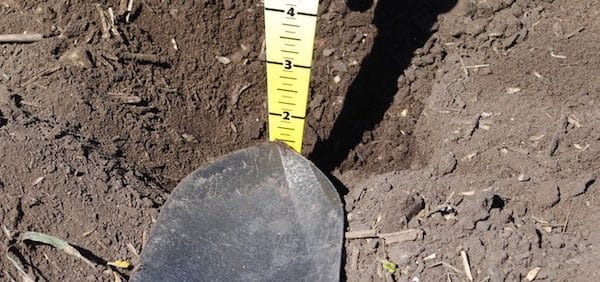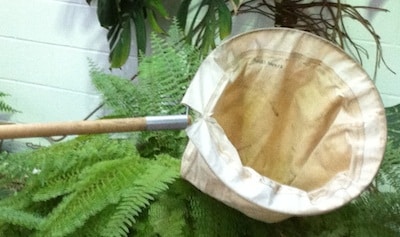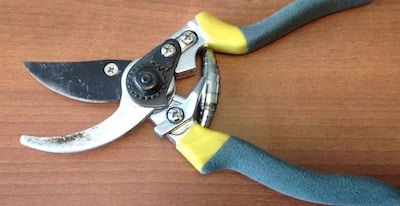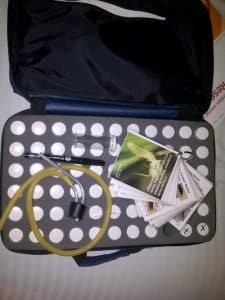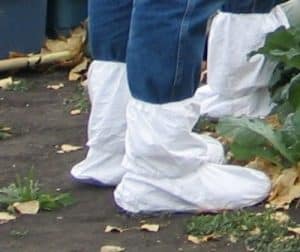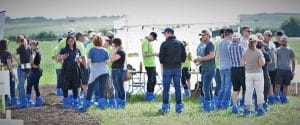Professional entomologists, plant pathologists and agronomists use many of these tools. Growers may want to keep some or all of them handy as well.
Mobile device
Smart phones and mobility-enabled tablets could be the most valuable scouting tools. They allow us to phone or text from the field for immediate back up or second opinions, including your local CCC agronomy specialist or through Twitter and other social media platforms. Apps can help with record keeping and pest identification. GPS functions can pinpoint exact scouting locations. Their cameras are particularly valuable for photographing pests you cannot identify or any other field observations. Take a lot of pictures, from various angles, ensuring the pest in question is in focus. Carry plain white paper to hold behind the pest. This makes it easier get the camera focused on the pest instead of the crop or landscape in the background. Macro (close up) lenses for smart phones help take focused close ups for easier ID. For ID queries, collect these four basic pieces of information for each photo: What crop is the insect in (and where on the plant was it found), location of the field (GPS if possible or turn on ‘location settings’ in the the camera app), name of the person who collected the sample or took the photo, and the date. Photography tips for agronomy.
Seed depth tool
Growers can use the tool to make sure every run of the drill places canola at the recommended half inch to one inch depth. Click here for tips on where and how to check seed depth.
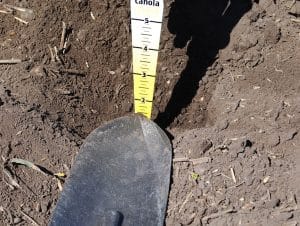
Hand trowel
Hand trowels are handy for wireworm and cutworm scouting, and trowels with depth markings on them can also be used to determine the depth from which seedlings are emerging while evaluating health of hypocotyls and roots. When scouting for underground cutworms, look above-ground for bare patches, holes or notches in foliage, and clipped plants. Start digging where you find damaged or missing plants. In moist soils, cutworms will stay close to the surface. In dry soils, they may go down 8-10 cm (up to 4”). They may also go deeper in the afternoon heat, so this may not be a great time to scout. To scout, dig up soil from a one square foot area to a depth of 10 cm and put it into a basin. Loosen the soil and shake it up to activate cutworms. Repeat a few times throughout the field. A sieve can help separate insects from dry soil. Find a sieve or strainer with holes big enough for your soil type.
Standard sweep net
Lygus bug and cabbage seedpod weevil economic thresholds are based on sweep net counts, and proper counts depend on using the standard sweep net and technique. The standard size has a 35” long handle and 15” (38 cm) diameter net. Lygus can show up in all areas of the Prairies, but even if you don’t typically have lygus or cabbage seedpod weevil, a sweep net can be useful to identify the presence of beneficial insects, diamondback moth larvae and other insect pests. Alberta’s government site has info on where to buy them.
Large baggies, especially the breathable ones, are a handy companion for the sweep net. Flying insects can pop out of the net quickly, making it harder to do an accurate count. Carefully dump all contents into the bag, then count insects through the perforated bag.
Note: Sweep net sampling is notoriously variable. Making a spray decision based on one set of 10 sweeps means a high chance of making the wrong decision. Extension entomologists recommend a minimum of 5 sampling sites, in a W or X pattern throughout the field, with 10 sweeps at each site. With lygus in particular, time of day, temperature and wind speed can make a difference in counts. You may want to scout two days in a row, unless average numbers are well above threshold.
Magnifying glass/hand lens
A 10X magnifying glass can be used to identify different insect species based on specific markings, to identify very small insects, such as thrips, to spot pycnidia in blackleg lesions, and to look at the growing points of frosted canola to see if they’re regrowing.
Three sided or two sided “square”
Some insect thresholds are based on counts per square foot or square metre, so use a two or three sided “square” to slip more easily into a heavy canopy and help you more accurately estimate the area of your counts. A home-made two-sided square, with a grid on each length showing one foot, half metre and full metre lengths will serve multiple purposes. With open sides, the square slips into the canopy more easily than a full square. For bertha armyworm, for example, lay down the square with the half metre length on each side. Remove leaf litter to count berthas on the ground and give canola plants a shake to remove berthas from the plants. Count the berthas that fall into that half metre by half metre square. Multiply by four to get the count per square metre. This quiz has lots of scouting tips.
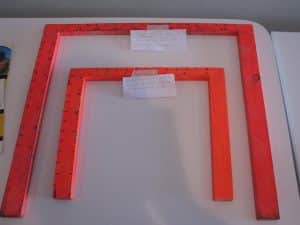
Hoop or metre stick
Plant counts can help you assess whether the stand has reached the optimum density of 50-80 plants per square metre (5-8 per square foot), and whether these stands are uniform throughout the field. This can help with reseeding decisions and seeding rate assessment, and in future decisions about pest threats and whether thresholds should be lowered if plant stands are at critical low levels. How to do counts with a metre stick or hoop.
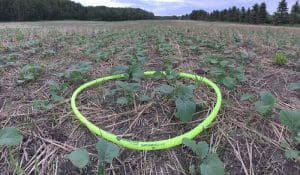
Clippers
To check fields for incidence and severity of blackleg, you want to clip stems just before swathing and look at their cross sections. How to ID and scout for blackleg. Clippers provide a nice clean cross section, better than a jack-knife. Splitting stems by hand is too difficult and destructive to provide a good cross section. Spend the money on a good set that can cut through a large canola stem cleanly. Buy stainless steel (avoid carbon steel) so they can be disinfected and will not rust.
Containers for samples
Growers and agronomists scouting fields are often the first line of defense when it comes to identifying first arrivals each year and identifying new insect pests. But this defense is useless if the insect can’t be identified. Vials or sturdy plastic containers will keep insects in good shape while in transport to the lab.
Bags. Plastic baggies with perforations work really well for grasshoppers. Paper bags work for keeping samples of stems covered with aphids. Paper bags are better for plant samples for disease ID because paper avoids mold and decomposition that can occur in plastic.
Aspirators can help suck insect specimens off a plant and put them into the vials. An aspirator plugs into the top of the vial, and has hoses going in and out. You suck on one end and hold the other end up to insect, vacuuming them up the hose and into the vial. This is faster than tweezers and does less damage to the insect making identification easier.
Booties
Biosecurity is important for anyone moving from field to field and farm to farm. Mud on the bottom of boots can spread noxious weed seeds and clubroot spores. The amount of soil required to initiate clubroot infection in a new field is unknown. Therefore, any soil transfer from an infested field should be viewed as a risk. Growers and agronomists and anyone else who walks fields is encouraged to use disposable booties, regardless if there is confirmed clubroot in their region (often clubroot is only found after there is a fairly established infestation). Veterinary offices often have booties for sale. The blue booties used in the photo above are from Vetsource. Use one set of booties per field, and dispose of used ones properly. If rubber boots are worn without booties, they will need to be scraped clean, washed (washing can be done in a 20L pail or a Rubbermaid type container with lid) and disinfected before the next visit. Include a spray bottle of effective disinfectant (see next heading) for cleaning boots and equipment between fields and garbage bags for disposal of booties or to wrap contaminated equipment. How to ID and scout for clubroot.
Disinfectant
Use only those products known to be effective on clubroot spores. These include bleach, Spray Nine and Premise Degreaser Plus. If using bleach, use only sodium hypochlorite. Target a 2% concentration of bleach to water (about 50/50 blend of regular 4% household bleach and water). Do not buy bleach unless the jug specifies sodium hypochlorite. Bleach degrades fairly quickly, so purchase quantities you can use quickly. Discard bleach after the bottle has been open for 3 months. Check best before dates for unopened bottles. Use approved products in a boot bath and for misting bottles to sanitize tools. Other scouting kit tools to clean gear between fields can include wire brushes and scrapers, disinfectant wet wipes and boot baths. Bleach and effective alternatives.
Flags
If you find an area with suspicious weeds, disease lesions, or building insect populations, it can be helpful to mark them so you can come back to that same spot and monitor the potential problem. Plastic stemmed flags are preferred in case you forget them in the field. They won’t damage the swather or combine header.
Gloves
Nitrile or latex gloves should be part of your biosecurity kit, and can keep your hands clean when handling insects, plant roots, etc.
Light-coloured sheet
Entomologists will have expandable white sheets made from plasticized material. It has cross pieces underneath to keep corners square. Entomologists put them down before shaking plants to release aphids, caterpillars or other insects to do accurate counts. A sheet or piece of cardboard can be just as effective.
Cooler or insulated bag
Keeping insect or plant samples in good condition is much easier in cool conditions. Even without an icepack, the closest gas station likely has ice or something frozen you can use for an icepack.
The random essentials
A notebook and pen, either the real thing or an electronic version, is handy to record details of areas to return to for monitoring, noting distribution of disease, sampling, etc. Also have a grease pencil or Sharpie on hand to mark containers. Tape, scissors and zip ties are also handy.
Resource material
Keep Canola Council of Canada pest management publications and a link to the Canola Encyclopedia on hand for identification of diseases, insects, weeds and nutrient deficiencies. Get the annual crop protection guide from the provincial ag departments. Sign up for Canola Watch.

